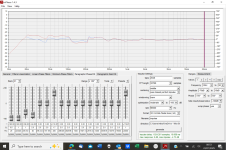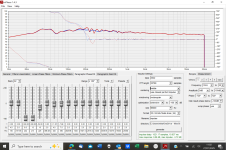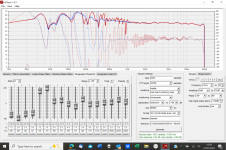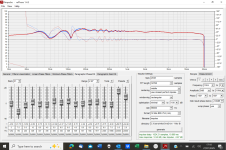I set the impulse panel as shown on the attachment, moderate optimisation seemed to give better results, i now need to learn how to get best results from smallish (?) taps power.
That seemed to help
6 phase EQ's got me +-90, how terrible is that?
M
That seemed to help
6 phase EQ's got me +-90, how terrible is that?
M
Attachments
Todays update, i created and loaded and listened through some FIR based filters, mostly to prove i could do that.
No great structured listening session, but sounded to have good focus and clarity.
However, in getting there i read that my amount of Taps wont allow phase correction in the bass, i am not sure what those limitations are or how much they matter. Further, i just roughed out some EQ in 10 minutes so phase above 120Hz remained within+/- 10 or 20 degrees. how close do i need to get that for acceptable results? - and whats the truth about the bass if anyone might advise please?
I didn't yet measure the actual result, only looking at the predictions in Rephase so far.
M
No great structured listening session, but sounded to have good focus and clarity.
However, in getting there i read that my amount of Taps wont allow phase correction in the bass, i am not sure what those limitations are or how much they matter. Further, i just roughed out some EQ in 10 minutes so phase above 120Hz remained within+/- 10 or 20 degrees. how close do i need to get that for acceptable results? - and whats the truth about the bass if anyone might advise please?
I didn't yet measure the actual result, only looking at the predictions in Rephase so far.
M
I'd say the only thing that really matters is that you enjoy what you hear?
If there are no big suck-outs in bass or any other huge hick-up I wouldn't worry about it too much. Perfecting phase while still having relatively strong reflections could muck up more than it solves. So as long as you feel you're getting satisfying results, do not worry about the smaller things, right? If you would chase a lower reflection level and more phase work at bass frequencies I promise you, you're going to want to add some kind of ambience again, I know, I've been there 😀.
Just enjoy a couple of good songs and rate your listening experience. No idea if it's anything you'd like but listen to (in no particular order):
Pink Floyd - the intro from Time & Money
Pink Floyd - The Wall part II
Infected Mushroom - Afratz
Infected Mushroom - Shakawkaw
Arjan Lucassen - The New Real
The Eagles - Hotel California from When Hell Freezes Over
Malia & Boris Blank - Celestial Echo
Pirates of the Caribbean, On Stranger Tides OST - Angry and Dead Again
Pirates of the Caribbean, On Stranger Tides OST - Angelica
Or simply focus on music that you love to hear. All songs above are pretty spectacular in imaging aside from liking the genre or song.
I've got many many more but this will do as a short list.
If there are no big suck-outs in bass or any other huge hick-up I wouldn't worry about it too much. Perfecting phase while still having relatively strong reflections could muck up more than it solves. So as long as you feel you're getting satisfying results, do not worry about the smaller things, right? If you would chase a lower reflection level and more phase work at bass frequencies I promise you, you're going to want to add some kind of ambience again, I know, I've been there 😀.
Just enjoy a couple of good songs and rate your listening experience. No idea if it's anything you'd like but listen to (in no particular order):
Pink Floyd - the intro from Time & Money
Pink Floyd - The Wall part II
Infected Mushroom - Afratz
Infected Mushroom - Shakawkaw
Arjan Lucassen - The New Real
The Eagles - Hotel California from When Hell Freezes Over
Malia & Boris Blank - Celestial Echo
Pirates of the Caribbean, On Stranger Tides OST - Angry and Dead Again
Pirates of the Caribbean, On Stranger Tides OST - Angelica
Or simply focus on music that you love to hear. All songs above are pretty spectacular in imaging aside from liking the genre or song.
I've got many many more but this will do as a short list.
Informative and thought provoking as always, thankyou.
I am not an experienced audio person with masses of experiences to reflect on, mine is almost entirely my own experiences at home, and rarely with the ability to simply A/B a comparison, and my brain rapidly forgets previous experiences as well.
(By the Way, you must operate at a much higher rate than i do in all you do, to cover so much ground!)
With all that as a background thought, i have enjoyed listening since my latest Filter implementation.
One simple example being voice. I listen to TV through this system as well as music sources and TV single or multiple voices are better defined, focussed and clarified now, the same effect in music.
I like that and could leave well alone, however i believe there will be more to have, so would like to explore further.
By this i mean a better implementation and/or strategy with the same equipment and room situation.
Concerning the room, there is little (more later) i can realistically do on my right hand speaker because the centre of the first reflection point is occupied by a radiator and a window. However, although the area closer to the speaker than those "obstacles" is a wall, the opportunity there is small and thin.
More - I may build a unit across the front wall between the speakers to include an equipment shelf, record and CD storage etc, and that might include some room treatment and wall facing the full height of that wall.
However that's a few months away at least.
So back to implementing things with what i have.
I understand there are limitations with the Flex, i quote a note concerning the Flex, " If you're considering correction in bass using FIR such filters will not do much as they're just too short. So most likely you will correct bass with parametric EQ and mids, treble and phase with FIR."
Now, i don't yet understand why the filters are "just too short", but i guess that's correct.
I will try to understand the subject better to grasp that, and have a go at revising the strategy a bit that way as well.
Meanwhile, I shall be enjoying the listening!
M
I am not an experienced audio person with masses of experiences to reflect on, mine is almost entirely my own experiences at home, and rarely with the ability to simply A/B a comparison, and my brain rapidly forgets previous experiences as well.
(By the Way, you must operate at a much higher rate than i do in all you do, to cover so much ground!)
With all that as a background thought, i have enjoyed listening since my latest Filter implementation.
One simple example being voice. I listen to TV through this system as well as music sources and TV single or multiple voices are better defined, focussed and clarified now, the same effect in music.
I like that and could leave well alone, however i believe there will be more to have, so would like to explore further.
By this i mean a better implementation and/or strategy with the same equipment and room situation.
Concerning the room, there is little (more later) i can realistically do on my right hand speaker because the centre of the first reflection point is occupied by a radiator and a window. However, although the area closer to the speaker than those "obstacles" is a wall, the opportunity there is small and thin.
More - I may build a unit across the front wall between the speakers to include an equipment shelf, record and CD storage etc, and that might include some room treatment and wall facing the full height of that wall.
However that's a few months away at least.
So back to implementing things with what i have.
I understand there are limitations with the Flex, i quote a note concerning the Flex, " If you're considering correction in bass using FIR such filters will not do much as they're just too short. So most likely you will correct bass with parametric EQ and mids, treble and phase with FIR."
Now, i don't yet understand why the filters are "just too short", but i guess that's correct.
I will try to understand the subject better to grasp that, and have a go at revising the strategy a bit that way as well.
Meanwhile, I shall be enjoying the listening!
M
It's your journey, we are just along for the ride 😀.
So take it as far as you wish, I sure have... 😉
So take it as far as you wish, I sure have... 😉
While your are at it, I would go for say within +/- 5 deg 100Hz ->6 phase EQ's got me +-90, how terrible is that?
If you run out of EQ range, just use the next Bank and continue to tweak...
Edit: OK, I see you run out of taps under 300 Hz...
//
"... and you can use the phase compensation settings for crossovers to help you out."
I wondered if there was a big chunk i could gain for little resource that way but of course am way out my depth to achieve that...............?
I wondered if there was a big chunk i could gain for little resource that way but of course am way out my depth to achieve that...............?
Well, every tweak of the phase does cost some room within the limited FIR taps/file length you have available.
But using the phase compensation option within RePhase might make it easier to get rid of some excess phase rotation making it a simpler job to phase EQ the rest of it.
I'm not used to limited amount of taps and use 65536 taps on the PC. That's a whole lot more than 2048 right? So at best you'll get an approximation with that limited tap count.
But using the phase compensation option within RePhase might make it easier to get rid of some excess phase rotation making it a simpler job to phase EQ the rest of it.
I'm not used to limited amount of taps and use 65536 taps on the PC. That's a whole lot more than 2048 right? So at best you'll get an approximation with that limited tap count.
I found the paragraphic phase EQ operation quite easy to understand but i have no idea (yet) about those filters operations.
So another process to learn about...........
I am sure i can find a read somewhere to understand some basics, so far i only find descriptions concerning crossovers
So another process to learn about...........
I am sure i can find a read somewhere to understand some basics, so far i only find descriptions concerning crossovers
This might help? The Phase Linearization tab in RePhase is meant to compensate for a true crossover but can also be used for the linearization of the phase wraps in your case. You can set it as steep as needed and at any frequency you want. If it fits well within the limited tap size is another matter though.

You can use this for the larger correction of phase wraps and use phase EQ to fine-tune. You don't need to correct the actual roll-off of your arrays, just aim for the phase to follow minimum phase over the frequency curve you've dialed in. So if your frequency curve starts to roll off at say 30 Hz (to name a figure) don't correct the phase below that.
You can use this for the larger correction of phase wraps and use phase EQ to fine-tune. You don't need to correct the actual roll-off of your arrays, just aim for the phase to follow minimum phase over the frequency curve you've dialed in. So if your frequency curve starts to roll off at say 30 Hz (to name a figure) don't correct the phase below that.
Last edited:
I tried implementation in Filters Lineraisation and it looked good until i hit create, it seems i may still be limited by the "power" available!
I found an apparently relevant thread in the MiniDSP forum and to save some of your kind efforts asked what i copy in below:
I have picked up here as i have searched for answers about using Flex with Rephase and i have seen some good knowledge emerging here that i am sure can move me forward from my inexperienced and unknowledgeable position.
I hope someone might help.
I have implemented some experimental filters generated in Rephase through the output channels on my Flex and there are noticeable improvements already.
I experienced the inability to correct at the lower frequencies and can see the reasons explained here, even though i don't understand the reason why, i perceive, from above, that a number of taps are needed to achieve the length of filter to cope with longer wavelengths in lower frequencies but don't understand the relationship.
It would be great if someone might give a simple explanation of that please.
And if anyone can help with questions below that would be great, or point me to read about them!
1. Then, even if i don't understand it in detail, am i limited to above 100Hz with the Flex using Rephase?
2. If so, how many tweaks in the para graphic phase and amplitude EQ above 100Hz can i make, does that all use up taps bit by bit?
Can you see how many taps any particular adjustment makes?
3. Is there any way to make corrections below 100Hz, i tried under the filters linearisation tab and it all looked fine at the settings stage but went wild after create was checked!
4. What happens with optimisation, my experiments show that using mild optimisation often shows a closer prediction to the adjustment than a heavy optimisation
All help greatly appreciated,
M
As i understand more i shall keep on trying!
Meanwhile, i observe two things with the current set up, when i describe clarity and coherence, i would explain this as being able to hear a reproduction clearly at lower volumes than before and in more detail.
Then an interesting effect, i was listening to a concert (TV programme) yesterday and enjoying how the setup was reproducing it, when at one point i went into an adjoining room with no door the sound was pervasive, in that i could listen easily in there as well, two or three times the distance away, obviously with no imaging etc, but interesting.
M
I found an apparently relevant thread in the MiniDSP forum and to save some of your kind efforts asked what i copy in below:
I have picked up here as i have searched for answers about using Flex with Rephase and i have seen some good knowledge emerging here that i am sure can move me forward from my inexperienced and unknowledgeable position.
I hope someone might help.
I have implemented some experimental filters generated in Rephase through the output channels on my Flex and there are noticeable improvements already.
I experienced the inability to correct at the lower frequencies and can see the reasons explained here, even though i don't understand the reason why, i perceive, from above, that a number of taps are needed to achieve the length of filter to cope with longer wavelengths in lower frequencies but don't understand the relationship.
It would be great if someone might give a simple explanation of that please.
And if anyone can help with questions below that would be great, or point me to read about them!
1. Then, even if i don't understand it in detail, am i limited to above 100Hz with the Flex using Rephase?
2. If so, how many tweaks in the para graphic phase and amplitude EQ above 100Hz can i make, does that all use up taps bit by bit?
Can you see how many taps any particular adjustment makes?
3. Is there any way to make corrections below 100Hz, i tried under the filters linearisation tab and it all looked fine at the settings stage but went wild after create was checked!
4. What happens with optimisation, my experiments show that using mild optimisation often shows a closer prediction to the adjustment than a heavy optimisation
All help greatly appreciated,
M
As i understand more i shall keep on trying!
Meanwhile, i observe two things with the current set up, when i describe clarity and coherence, i would explain this as being able to hear a reproduction clearly at lower volumes than before and in more detail.
Then an interesting effect, i was listening to a concert (TV programme) yesterday and enjoying how the setup was reproducing it, when at one point i went into an adjoining room with no door the sound was pervasive, in that i could listen easily in there as well, two or three times the distance away, obviously with no imaging etc, but interesting.
M
Latest report on the journey.......This might help? The Phase Linearization tab in RePhase is meant to compensate for a true crossover but can also be used for the linearization of the phase wraps in your case. You can set it as steep as needed and at any frequency you want. If it fits well within the limited tap size is another matter though.
View attachment 1412539
You can use this for the larger correction of phase wraps and use phase EQ to fine-tune. You don't need to correct the actual roll-off of your arrays, just aim for the phase to follow minimum phase over the frequency curve you've dialed in. So if your frequency curve starts to roll off at say 30 Hz (to name a figure) don't correct the phase below that.
I had a good play around with Rephase to try and achieve this suggestion (thanks for it) and although all looks good in the setting up, as soon as i push create with the Flex settings in place the lower frequency phase corrections go wild again, so it seems this does not escape the frequency limitation caused by relatively few Taps and High rate of Flex.
My new reading says this is approximated by (Rate/Taps)*3, so ~(96,000/2000)*3=~150 Hz, but REW doesnt use all the Filters at that level, so i thought to go higher.
So i am considering a new overall EQ strategy which is basically;
1. To do the EQ up to say 3-400 Hz (although i could go to nearer 150Hz and use the remaining capacity to basically straighten the amplitude response more widely) with the input channels on the flex using REW generated Biquads based on the time aligned, FDW'd, Vector averaged inputs from say 9 positions for each channel separately. Experiments already suggest this will follow the target curve quite closely and then
2. Measure again at the main listening position, process as above and EQ above 300Hz for phase and amplitude against the target curve in Rephase and load those FIR filters in the output channels which again seem to have the capability to take that from my experiments.
Now of course there are many questions.
1. specifically is whether and how i should time align/compensate L and R at the listening position, I know inevitably that one speaker is further than the other, but that's always going to vary at different listening positions..........
M
What you do is that you pass the FR EQ results from a REW auto EQ session to rePhase so that all the levers are set automatically in rePhase. It takes two imports in rePhase - one for EQ data and one for phase. You still have to tweak the phase manually if you want that...
At least that is how understand it and have made it.
So the target curve is achieved by using a target curve in REW EQ and then export the EQ PEQs data - so no targets to rePhase for FR. And not for phase either - you need to tweak it by hand to zero as you have already done...
//
At least that is how understand it and have made it.
So the target curve is achieved by using a target curve in REW EQ and then export the EQ PEQs data - so no targets to rePhase for FR. And not for phase either - you need to tweak it by hand to zero as you have already done...
//
Did you use a frequency dependent window to export to RePhase? I'd say 6 cycles being enough to prevent over-correction. Obviously, the right side suffers from being close to the corner and has lots of reflection within that measurement. I'm hoping a 6 cycle window might reduce the consequences of the reflections somewhat?
I have gone for 4 as an experiment.
However i cannot get it to save as .bin, which i need, even though i believe i set it to do so..............
I will have set something wrong but dont know what?
Any ideas welcome and i shall play around meanwhile!
However i cannot get it to save as .bin, which i need, even though i believe i set it to do so..............
I will have set something wrong but dont know what?
Any ideas welcome and i shall play around meanwhile!
Attachments
- Home
- Loudspeakers
- Full Range
- Another corner array project



